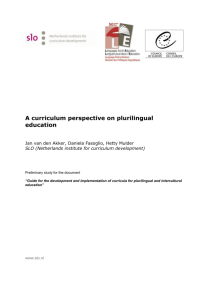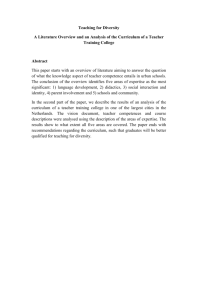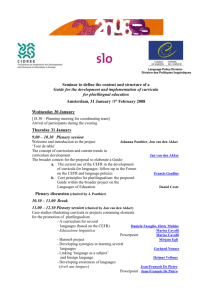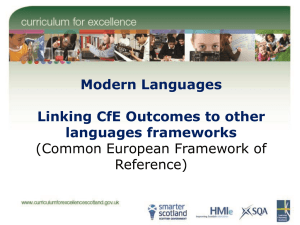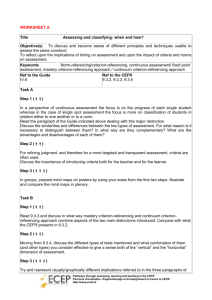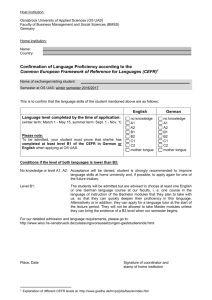A curriculum perspective on plurilingual education
advertisement
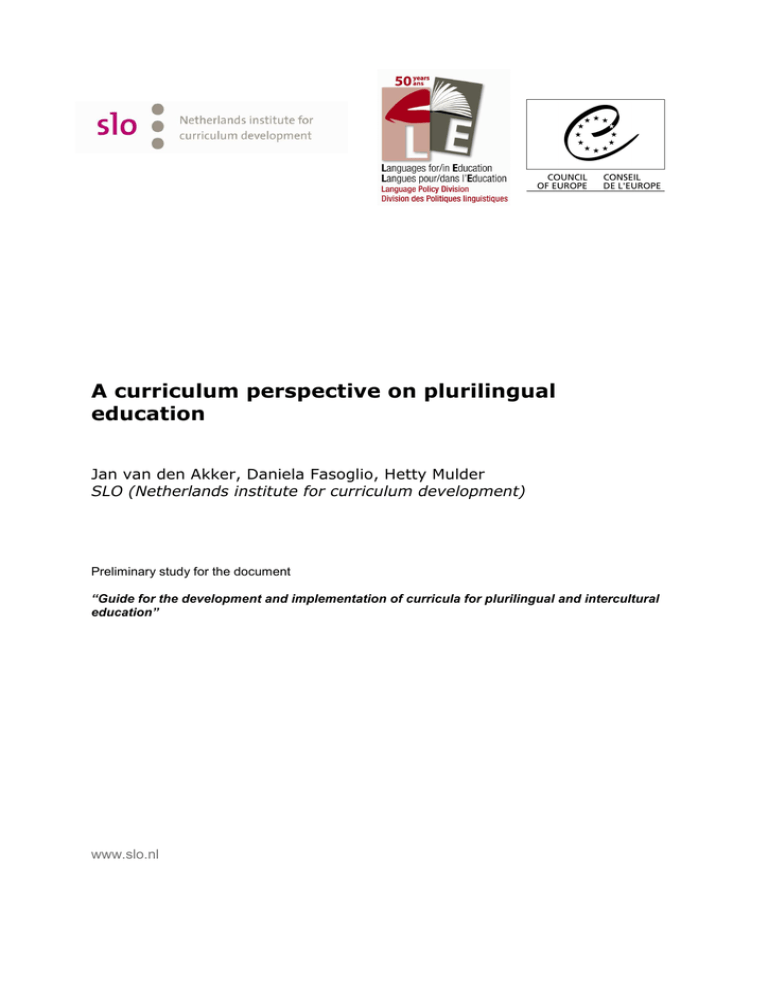
A curriculum perspective on plurilingual education Jan van den Akker, Daniela Fasoglio, Hetty Mulder SLO (Netherlands institute for curriculum development) Preliminary study for the document “Guide for the development and implementation of curricula for plurilingual and intercultural education” www.slo.nl Preliminary study prepared in October 2008 by Jan van den Akker, Daniela Fasoglio, Hetty Mulder from SLO (Netherlands institute for curriculum development) for the document “Guide for the development and implementation of curricula for plurilingual and intercultural education” published by the Council of Europe in September 2010 (www.coe.int/lang) © SLO The opinions expressed in this work are those of the authors and do not necessarily reflect the official policy of the Council of Europe. The document has been published with the kind permission of the authors, who keep the copyright on the document. The reproduction of extracts is authorised, except for commercial purposes, on condition that the source is quoted. All correspondence concerning this publication or the reproduction or translation of all or part of the document should be addressed to SLO, P.O. Box 2041, 7500 CA Enschede The Language Policy Division is grateful to SLO for making this study available at European level as a contribution to its Project on Languages in Education – Languages for Education (www.coe.int/lang). TABLE OF CONTENTS 1. Defining curriculum and curriculum development........................................................... 5 2 Different curriculum representations and analytical perspectives ................................... 6 3 The vulnerable curriculum spider web............................................................................ 7 4 Learning languages in a spider web .............................................................................. 8 5 Perspectives on substantive choices ............................................................................10 6 Development strategies ................................................................................................12 7 Strategic dilemmas and puzzles ...................................................................................13 8 Examples at school and classroom level ......................................................................15 References...........................................................................................................................17 A curriculum perspective on plurilingual education Jan van den Akker, Daniela Fasoglio, Hetty Mulder A guide for the elaboration of curricula for plurilingual and intercultural education cannot do without an introduction on the notion of curriculum. The three of us, working at SLO (Netherlands institute for curriculum development) are convinced that a curricular perspective has a lot to offer, both in a conceptual approach of educational problems as well as in how to address concrete development activities. To illustrate this, we will make an effort to ‘reinvent’ a broad curriculum perspective in this chapter (elaborating on van den Akker, 2003) and, where possible, we will illustrate the broad curriculum perspectives with applications for language learning and for plurilingual and intercultural education. 1. Defining curriculum and curriculum development When there is a myriad of definitions of a concept in the specialist literature (as is the case with curriculum), it is often difficult to keep a clear focus on its essence. It often helps, then, to search for the etymological origin of the concept. The Latin word 'curriculum' refers to a 'course' or 'track' to be followed. In the context of education, where learning is the central activity, the most obvious interpretation of the word curriculum is then to view it as a course or 'plan for learning' (cf. Taba, 1962). This very short definition (reflected in related terms in many languages) limits itself to the core of all other definitions, permitting all sorts of elaborations for specific educational levels, contexts, and representations. Given this simple definition, a differentiation between various levels of the curriculum has proven to be very useful when talking about curricular activities: • supra: international, comparative • macro: system, society, nation, state • meso: school, institution, program • micro: classroom, group, lesson • nano: individual, personal. The macro and micro are more or less classical in educational literature. The supra level becomes increasingly visible through international policy discussions, where common aspirations and frameworks are formulated - the Common European Framework of Reference for language learning, teaching and assessment is a good example of this tendency within Europe. Countries want to compare their educational productivity, for instance via large scale studies as PISA and TIMSS. The meso level is especially prominent in countries (such as the Netherlands) where schools are supposed to be active in developing their own profile. The nano level relates to the growing emphasis on individual responsibility for (life-long) learning and development, resonating both societal trends as well as socio-constructivist visions. The process of curriculum development can be seen as narrow (developing a curricular product) or broad (comprehensive and ongoing improvement). In order to successfully address tasks of curriculum decision-making and enactment, a broader description of curriculum development is often most appropriate: usually a long and cyclic process with many stakeholders and participants, in which motives and needs for changing the curriculum 5 are formulated, ideas are specified in programs and materials, and efforts are made to realize the intended changes in practice. Foreign languages have found a perfect reference point for going across a broad curriculum development process in the Common European Framework of Reference (CEFR). The CEFR formulates targets of FL learning, describes what language learners have to do in order to achieve communication goals successfully and defines levels of language proficiency in order to measure language progress. It provides a common basis for a broad curricular approach to FL learning and for the elaboration of national programs and materials across Europe; it situates plurilinguism in a broad curricular perspective by describing and giving formal recognition to partial skills, making (general and specific) language learning objectives explicit and enhancing language learning awareness. 2 Different curriculum representations and analytical perspectives Curricula can be represented in various forms (cf. van den Akker, 1998, 2003). Clarification of those forms is especially useful when trying to understand the problematic efforts to change the curriculum, as often manifested in major gaps between ideals and outcomes. A common broad distinction is between the three levels of the 'intended', 'implemented', and 'attained' curriculum. A more refined typology is outlined in Box 1. INTENDED Ideal Vision (rationale or basic philosophy underlying a curriculum) Intentions as specified in curriculum documents and/or materials Curriculum as interpreted by its users (especially teachers) Actual process of teaching and learning (also: curriculum-in-action) Learning experiences as perceived by learners Resulting learning outcomes of learners Formal/Written IMPLEMENTED Perceived Operational ATTAINED Experiential Learned Box 1. Typology of curriculum representations Besides this differentiation in representations, curriculum problems can be approached from various analytical angles. For example, Goodlad (1994) distinguishes the following three different perspectives: • substantive, focusing on the classical curriculum question about what knowledge is of most worth for inclusion in teaching and learning • technical-professional, referring to how to address tasks of curriculum development, especially the challenge how to bridge the gaps between intentions, realities and outcomes • socio-political, referring to curriculum decision-making processes, where values and interests of different stakeholders and agencies are at stake. Some might argue that this list is too limited as it does not include the more 'critical' perspectives that are amply present in curriculum theory literature (e.g. Pinar, Reynolds, Slattery & Taubman, 1995). However, as critical curriculum theory often focuses on analysis of what is wrong in education (running through each of the previous angles), the threefold distinction seems adequate for a developmental and improvement perspective. 6 3 The vulnerable curriculum spider web One of the major challenges for curriculum improvement is creating balance and consistency between the various components of a curriculum (i.e. plan for learning). What are those components? The relatively simple curriculum definition by Walker (1990) includes three major planning elements: content, purpose and organization of learning. However, curriculum design and implementation experiences have taught us that it is wise to pay explicit attention to a more elaborated list of components. We have come to adhere to a framework (see box 2) of ten components that addresses ten specific questions about the planning of student learning (cf. van den Akker, 2003). Rationale Aims & objectves Content Learning activities Teacher role Materials & resources Grouping Location Time Assessment Why are they learning? Toward which goals are they learning? What are they learning? How are they learning? How is the teacher facilitating their learning? With what are they learning? With whom are they learning? Where are they learning? When are they learning? How to assess their learning progress? Box 2. Curriculum components The 'rationale' (referring to overall principles or central mission of the plan) serves as major orientation point, and the nine other components are ideally linked to that rationale and preferably also consistent with each other. For each of the components many sub-questions are possible. Not only on substantive issues, but, for example, also on 'organizational' aspects as: • • • Grouping: o How are students allocated to various learning trajectories? o Are students learning individually, in small groups, or whole-class? Location: o Are students learning in class, in the library, at home, or elsewhere? o What are the social/physical characteristics of the learning environment? Time: o How much time is available for various learning domains? o How much time can be spent on specific learning tasks? The relevance of these components varies across the previously mentioned curriculum levels and representations. A few examples may illustrate this. Curriculum documents at the macro level will usually focus on the first three components (rationale, aims & objectives, content; often in rather broad terms), sometimes accompanied by an outline of time allocations for various subject matter domains. When one takes the operational curriculum in schools and especially classrooms in mind, all ten components have to be coherently addressed to expect successful implementation and continuation. The components of learning activities, teacher role, and materials & resources are at the core of the micro-curriculum. The component of assessment deserves separate attention at all levels and representations since careful alignment between assessment and the rest of the curriculum appears to be critical for successful curriculum change. 7 Time As ses sm ent Our preferential visualization of the ten components is to arrange them as a spider web (figure 1), not only illustrating its many interconnections, but also underlining its vulnerability. Thus, although the emphasis of curriculum design on specific components may vary over time, eventually some kind of alignment has to occur to maintain coherence. A striking example is the trend towards integration of ICT in the curriculum, with usually initial attention to changes in materials and resources. Many implementation studies have exemplified the need for a more comprehensive approach and systematic attention to the other components (in particular the role of teachers) before one can expect robust changes. L o cat ion Rationale Con te nt Grouping Teacher ro le M & ls ia er at Re ce ur so s Fig. 1. Curricular spider web The spider web also illustrates a familiar expression: every chain is as strong as its weakest link. That seems another very appropriate metaphor for a curriculum, pointing to the complexity of efforts to improve the curriculum in a balanced, consistent and sustainable manner. 4 Learning languages in a spider web The metaphor of a spider web can very well be used to illustrate the crucial points of FL curriculum development. As previously mentioned, national FL curricula will generally focus on rationale, aims & objectives and contents. These are all thoroughly described in the CEFR in a context-free scale and are relatable to any relevant context. Yet, national curricula will have to interpret the principles expressed in the CEFR relating them to local contexts and needs. 8 Rationale Language learners are seen as individual and social agents who perform language activities (tasks) as part of a wider social context. A task is described as "any purposeful action considered by an individual as necessary in order to achieve a given result in the context of a problem to be solved, an obligation to fulfil or an objective to be achieved." Language learning is seen in the perspective of several dimensions: strategies, language activities, general and communicative competences, contexts and domains. Aims & objectives A global scale of common reference levels is provided by the CEFR, further specified into scaled illustrative descriptors of language activities implying language production, reception, interaction and mediation. Content Reference Level Descriptions for national and regional languages describe language contents necessary to perform language activities in public, personal, educational and occupational contexts. Box 3. FL curriculum components at macro level according to the CEFR. The above framework shows how, thanks to the CEFR, the macro aspects of the curricular spider web for foreign language learning can be made consistent with each other across the European countries, that, in turn, will further specify them in national contextualization. Learning activities, teacher role, and materials & resources pertain to the micro-curriculum and their operationalization is often a responsibility of schools and of teachers, particularly in countries, such as the Netherlands, where schools may organize their education programme to a great extent autonomously. However, it is of crucial importance that the choices made are consistent: they should be aligned with the other aspects of the curricular spider web. The curriculum developer can play an essential role in supporting this process, and particularly in answering questions like the following: Learning activities Teacher role Materials & resources Which activities enhance the language learning process, when do language activities have a learning effect? Which activities are the most effective during the different stages of the language learning process? How can the learning effect of a language activity be enhanced? Which teacher's interventions (pedagogical interaction, dialogic discourse and feedback, metalanguage) are effective in enhancing the language learning process, and at which moment of the process should they be planned? What are the criteria for the selection of 'CEFR-proof' resources to be used in learning activities? Box 4. FL curriculum components at micro level according to the CEFR. Language assessment takes a particular position in the curricular spider web, as it pertains to both macro and micro levels. The CEFR devotes special attention to assessment (chapter 9, Appendix A), and provides qualitative and quantitative descriptors of aspects of proficiency presented as scales related to the levels of the Framework. In the Netherlands, at the macro level, the National Testing Institute (CITO) has taken part in some international projects aimed at relating language assessment to the CEFR. For example, the 'Dutch Grid' project has 9 produced a framework with criteria to assess the CEFR levels of texts and tasks for reading and listening. Other international activities focus on benchmarking speaking and writing performances based on the descriptors of the CEFR. All remarks made so far are not language specific and can be applied to any foreign language. This does not mean, however, that one could develop a plurilingual educational programme simply by adding more languages to the curriculum structure. In order to design a plurilingual curriculum, our spider web model should be expanded with an extra dimension. In plurilingual education languages share the same rationale but do not - or only partially overlap in objectives and contents, thus leaving space to partial or specific competences. An additional link, connecting activities and materials/resources specific for each language, focuses on similarities and differences between language structures and cultures. Language awareness gets its logical place in curriculum design. Fig. 2. Language awareness in the curricular spider web. 5 Perspectives on substantive choices A classic approach to the eternal curriculum question of what to include in the curriculum (or even more difficult as well as urgent: what to exclude from it?) is to search for a balance between three major sources or orientations for selection and priority setting: • • • Knowledge: what is the academic and cultural heritage that seems essential for learning and future development? Society: which problems and issues seem relevant for inclusion from the perspective of societal trends and needs? Learner: which elements seem of vital importance for learning and development from the personal and educational needs and interests of learners themselves? Answers to these questions usually constitute the rationale of a curriculum. 10 Inevitably, choices have to be made, usually involving compromises between the various orientations (and their respective proponents and pressure groups). Oftentimes, efforts fail to arrive at generally acceptable, clear and practical solutions. The result of adding up all kinds of wishes is that curricula tend to get overloaded and fragmented. Miscommunication between different stakeholders often arises from neglecting one or more of the orientations. And implementation of such incoherent curricula eventually tends to lead to student frustrations, failure, and dropout. A translation of the above selection criteria to FL curricula leads to the following three: • Knowledge: what language knowledge, knowledge of the world and sociocultural knowledge, particularly in respect of the country and the linguistic community by which the language is spoken, will the learner need to acquire? • Skills and attitudes: what social skills and skills related to daily or professional life will the language learner need to acquire in order to interact effectively in the country where the language is spoken? How can intercultural awareness, understanding and acceptation of the other and intercultural mediation be enhanced through language learning? • Individual needs: how is it possible, in a national curriculum, to keep reckon of particular purposes in language acquisition, like personal history, social, economical, geographical, cultural motives? The rationale of a FL curriculum usually gives answers to the first of the three groups of the above questions, but seldom, or insufficiently to the others. How to create a better curriculum balance? Easy answers are not available, but a few alternatives seem to have some promise. First, speaking in general terms, in view of the multitude of (academic) knowledge claims, it sometimes helps to reduce the big number of separate subject domains to a more limited number of broader learning areas, combined with sharper priorities in aims for learning (focusing on basic concepts and skills). Second, referring to the avalanche of societal claims, more interaction between learning inside and outside the school may reduce the burden. However, the most effective response is probably to be more selective in reacting to all sorts of societal problems. As Cuban (1992) phrased it clearly: schools should not feel obliged to scratch the back of society every time society has an itch. And third, about the learners' perspective: worldwide, many interesting efforts are ongoing to make learning more challenging and intrinsically motivating, by moving from traditional, teacher- and textbook-dominated instruction towards more personally meaningful and activity-based learning approaches and environments, emphasizing preparation for future roles in education, jobs and society. These alternatives, applicable to education in general, do seem nearly tailor-made for foreign languages. First, a good balanced FL curriculum focuses learning targets on explicit, attainable, realistic communicative objectives and selects language contents accordingly in a functional perspective (in terms of lexical and structural contents). Second, language learning experiences are not limited to the school context, on the contrary, a link to language exposure outside and beyond school can improve motivation and strengthen learning effects. We dare state that plurilingual and intercultural competences cannot even be achieved without a direct link to the real world. And third, an action-oriented approach constitutes the basis of the CEFR, situating language learning activities in realistic and meaningful contexts. Software applications and interactive 11 tools facilitate learner-centred learning and offer new possibilities to organize language learning activities: graphic presentation software, internet, e-mail, fora and chat, web-based applications are just some of the many tools available. 6 Development strategies To sketch curriculum development as a problematic domain is actually an understatement. From a socio-political stance, it often seems more appropriate to describe it as a war zone, full of conflicts and battlefields between stakeholders with different values and interests. Problems manifest themselves in the (sometimes spectacular and persistent) gaps between the intended curriculum (as expressed in policy rhetoric), the implemented curriculum (real life in school and classroom practices), and the attained curriculum (as manifested in learner experiences and outcomes). See, for example, van den Akker (1998) about such gaps in the science curriculum. A typical consequence of those tensions is that various frustrated groups of participants blame each other for the failure of reform or improvement activities. We will limit ourselves to shortly mention in this regard, as an example, the discussions taking place in the Netherlands about the position of some foreign languages in respect to others in the curricula of secondary education, about the amount of classes, and their compulsory character, or about the final targets to be achieved and their formal prescription in national curricula. Although such blaming games often seem rather unproductive, there are some serious, critical remarks to be made on many curriculum development approaches worldwide. First of all, many curriculum reform efforts are characterized by overly big innovation ambitions (especially of politicians) within unrealistically short timelines and with very limited investment in people, especially teachers. Second, oftentimes there is a lack of coherence between the intended curriculum changes with other system components (especially teacher education and assessment/examination approaches). Curriculum implementation always has an impact on teachers, but its success is determined by teachers, too. In order to provide for teachers' acceptation and involvement, teacher education institutes should offer CEFR modules as well as innovative plurilingual-oriented programs providing for familiarisation with the CEFR principles and acknowledgement of their benefits; only then will teachers be able to share rationale and goals, and be actively involved in implementation. Integration of curriculum development, school organisation development and teacher's professional development is a must when seeking for real chances of success in implementation. Last but not least, timely and active involvement of all relevant stakeholders is often neglected. Plurilingualism and intercultural awareness have a political, economical, social and educational relevance. Stakeholders in plurilingualism can be universities, linguistic research institutes, industries, international concerns and other participants in the labour market, and, last but not least, the learners themselves. . From a strategic point of view, literature has offered us many (technical-professional) models and strategies for curriculum development. Three prominent approaches are Tyler's rationallinear approach, Walker's deliberative approach, and Eisner's artistic approach. As it does not fit with the purpose of this text to explain those models in specifics, the reader is referred to educative texts as from Marsh and Willis (2003). Obviously, the context and nature of the curriculum development task at hand will determine to a large extent what kind of strategy is indicated. It is noteworthy that we are beginning to see more blended approaches that integrate various trends and characteristics of recent design and development approaches in 12 the field of education and training (for an overview and a series of examples: see van den Akker, Branch, Gustafson, Nieveen & Plomp, 1999). Some key characteristics: • Pragmatism: recognition that there is not a single perspective, overarching rationale or higher authority that can resolve all dilemmas for curriculum choices to be made. The practical context and its users are in the forefront of curriculum design and enactment. • Prototyping: evolutionary prototyping of curricular products and their subsequent representations in practice is viewed as more productive than quasi-rational and linear development approaches. Gradual, iterative approximation of curricular dreams into realities may prevent paralysis and frustrations. Formative evaluation of tentative, subsequent curriculum versions is essential to inform and support such curriculum improvement approaches. • Communication: a communicative-relational style is desirable in order to arrive at the inevitable compromises between stakeholders with various roles and interests and to create external consistency between all parties involved. • Professional development: in order to improve chances on successful implementation, there is a trend towards more integration of curriculum change and professional learning and development of all individuals and organizations involved. As we already mentioned before, professionalisation of language teachers (teacher students as well as in-service teachers) is a key point in the implementation process of a CEFR-based FL curriculum. A promising approach that incorporates some of these characteristics, and adds the element of knowledge growth to it, is development(al) or design research (van den Akker, 1999, 2002; van den Akker, Gravemeijer, McKenney & Nieveen, 2006). Such research can strengthen the knowledge base in the form of design principles that offer heuristic advice to curriculum development teams. More than in usual development practices, deliberate attention is paid to theoretical embedding of design issues and empirical evidence is offered about the practicality and effectiveness of the curricular interventions in real user settings. 7 Strategic dilemmas and puzzles However, there are still several persistent dilemmas in FL curriculum development that cannot easily be resolved, let alone through generic strategies. For example: how to combine aspirations for large-scale curriculum change and system accountability with the need for local or individual variations and ownership? Looking at the Dutch education system, we can mention quite a few examples in this regard. English occupies a different position in the curriculum of secondary education from the one taken by the other foreign languages, as it is the only language, besides Dutch, which is compulsory within all educational sectors. As far as the second, and possibly the third and the fourth language are concerned, it is the school itself that will determine between which languages the students may chose. German and French are automatically included in the school's gamut of languages, other languages, however, are not. In Friesland it is possible to include Frisian (the second official language in the Netherlands) in one's examination subjects; in areas close to the French or the German borders the language of our neighbours is chosen more frequently than in other areas of the country. Economical reasons can influence the students' choice; both the labour market and university and research institutions require knowledge in English and German, but also in French and Spanish. Worth mentioning is also, in this context, the increasing importance of other languages in international commerce, like Mandarin Chinese, Russian and Portuguese. 13 Yet there are other reasons, too, which deserve consideration in a national curriculum that aims at respect for individual needs and aspirations. Heritage languages, for instance, will concern smaller groups of students, who nevertheless would like to be facilitated in the fulfilment of their learning needs. Learning targets may vary in needs and specificity and, as such, concern more limited target groups: a learner may wish to acquire particular skills for a specific purpose, like being able to read texts about a specific topic, or to engage in social interaction, which does not necessarily imply a high general competence level. In the same way, there are specific reasons (like cultural ones) for which, for example, a language learner may want to learn Italian, or non-western languages such as Indonesian or Arabic. A challenge for the curriculum developer is, how to combine a large-scale curriculum with a need for diversity. The tension between these conflicting wishes can be somewhat reduced when one avoids the all too common 'one size fits all' approach. More adaptive and flexible strategies will avoid detailed elaboration and prescription through over-specified central curriculum frameworks. Instead, they offer substantial options and flexibility to schools, teachers, and learners. Although struggles about priorities in aims and content will remain inevitable, the principle of 'less is more' should be pursued. However, what is incorporated in a limited core curriculum should be clearly reflected in examination and assessment approaches. A CEFR-based language assessment can offer new possibilities to differentiate in targets between different languages and between language abilities and to measure the achievement of specific competences (or 'partial' competences, a term which we consider somewhat negative and therefore less desirable than the word 'specific', which does not carry a negative connotation). The 'enactment' perspective (teachers and learners together create their own curriculum realities) is increasingly replacing the 'fidelity' perspective on implementation (teachers faithfully following curricular prescriptions from external sources). That trend puts even more emphasis on teachers as key people in curriculum change. This certainly applies to language teachers, who are fully responsible for the organization of their language lessons and for the way in which they will stimulate students' language progress. A synergy between curriculum developer and language teachers is the basis of curriculum implementation. Teachers should, first, familiarize themselves with its rationale and share its principles and objectives, in order to participate in curriculum design and implementation process. Both individual and team learning is essential (Fullan, 2001). Teachers need to experience the blessing of cooperation. Collaborative design and piloting of curricular alternatives can be very productive, especially when experiences are exchanged and reflected upon in a structured curriculum discourse. Interaction with external facilitators can contribute to careful explorations of the 'zone of proximal development' of teachers and their schools. Crossfertilization between curriculum, teacher, and school development is a conditio sine qua non for effective and sustainable curriculum improvement. The increasingly popular mission statements of schools to become attractive and inspiring environments for students and teachers can only be realized when such integral scenarios are practiced. Obviously, there are no magical solutions for the tensions between common core and local autonomy. It will always remain a balancing act, also depending on the scale of operations 14 and the broader educational policy. In those policies, we see quite an interesting variation between countries in their respective pendulum movements. In recent years, the Netherlands has seen a trend towards decentralization. In basic education (ages 4-14), only two-third of the instructional is very broadly defined by rather abstract attainment targets (for foreign languages, only English is defined) in a national framework, leaving many choices to schools, teachers, and students. Some other countries are in a different position, characterized by highly detailed and prescriptive curriculum frameworks, oftentimes combined with heavy assessment regimes patterns. Whatever the position on the continuum of central-decentralized curriculum policy making, a number of debatable issues are relevant in any context: • How much commonality in curriculum offering is required to promote equity for students and to stimulate socio-economic development? • How can curriculum and assessment policies adequately be aligned? • Which accountability mechanisms are helpful for both policy and practice? • How to stimulate and support professional development of teachers? • How can schools’ capacity for educational improvement be strengthened? • How can external support to schools and teachers have actual added value? 8 Examples at school and classroom level What is the function of exemplary language programs and materials for schools and classroom? Top-down, detailed prescriptions are out of the question and not in line with the principles of the CEFR, which has a descriptive, not a prescriptive character. Hardly anyone is eager to receive nation-wide recipes. Schools and language teachers prefer local, schoolbased, and classroom-adapted customization. However, very few people like to completely reinvent the wheel. Schools and language teachers do like concrete, promising examples from other, more or less comparable contexts, if firmly rooted in practice: they need successful experiences and positive results, attainable materials, and feasible projects in order to achieve acceptance and later ownership of the action-based approach of the CEFR. SLO, as national institute for curriculum development, with a full range of curriculum experts across learning domains and education sectors, and a permanent overview of relevant development activities, is in the right position to identify, co-develop, and validate such examples and materials. Close interaction with local/regional practitioners and other professional partners in educational development is very important. The resulting examples are then not meant to copy, but to stimulate and support orientation on promising, concrete alternatives to current practices. They can help practitioners to re-think their own curriculum. This approach brings language teachers (and their school leaders) deliberately to the forefront of curriculum improvement. Starting from their own 'zone of proximal development', teachers can act as curriculum makers through collaborative design and piloting of alternative curriculum approaches. Discourse and reflection about alternatives and experiences can lead to development that is perceived as real improvement. It is evident that such curriculum improvement can only succeed when occurring in close interaction with teacher professional development and school capacity building for educational renewal. Thus, productive relations between curriculum, language teacher and school development are essential for local progress. 15 In line of the aforementioned approach, SLO aims at strengthening the interrelation between language teachers and curriculum development. One might argue that the quality of language teachers and the quality of the curriculum they use together contribute most to the language learning progress of students. For that reason, investing in relations and partnerships with teachers (including teacher educators and teacher associations), both locally, regionally, and nation-wide, is a top priority. We like to conclude this study with these considerations on the fundamental role of language teachers in curriculum development. The following chapters of this publication will show how different national contexts have translated some of the general considerations contained in this article into tailored language policies and practical projects in accordance with different specific plurilinguistic scenarios. We wish to thank our colleague Anne Beeker for her useful feedback. 16 References Akker, J. van den (2006). Curriculum development re-invented. In J. Letschert (Ed.), Curriculum development re-invented (pp. 16-30). Enschede: SLO. Akker, J. van den (1998). The science curriculum: Between ideals and outcomes. In B. Fraser & K. Tobin (Eds.), International handbook of science education (pp. 421-447). Dordrecht: Kluwer Academic Publishers. Akker, J. van den (1999). Principles and methods of development research. In J. van den Akker et al. (Eds.), Design approaches and tools in education and training (pp. 1-14). Dordrecht: Kluwer Academic Publishers. Akker, J. van den (2002). The potential of development research for improving the relationa between curriculum research and development. In M. Rosenmund, A. Fries, & W. Heller (Eds.), Comparing curriculum making processes (pp. 37-53). Bern: Peter Lang. Akker, J. van den, Branch, R., Gustafson, K., Nieveen N. & Plomp, T. (Eds.) (1999). Design approaches and tools in education and training. Dordrecht: Kluwer Academic Publishers. Akker, J. van den, Gravemeijer, K., McKenney, S. & Nieveen, N. (Eds.) (2006). Educational design research. London: Routledge. Council of Europe (2001), Common European Framework of Reference for Languages: learning, teaching, assessment. Cambridge: Cambridge University Press (available online: www.coe.int/lang). Cuban, L. (1992), Curriculum stability and change. In P. Jackson (Ed.), Handbook of research on curriculum (pp. 216-247). New York: Macmillan. Fullan, M. (2001). The new meaning of educational change. New York: Teachers College Press. Goodlad, J. (1994). Curriculum as a field of study. In T. Husén, & T. Poslethwaite (Eds.), The international encyclopedia of education (pp. 1262-1276). Oxford: Pergamon Press. Marsh, C., & Willis, P. (2003). Curriculum: Alternative approaches, ongoing issues (third edition). Upper Saddle River, NJ: Merrill/PrenticeHall. Onderwijsraad (2008), Advies Vreemde talen in het onderwijs. Den Haag: Onderwijsraad. Pinar, W., Reynolds, W., Slattery, P., & Taubman, P. (1995). Understanding curriculum. An introduction to the study of historical and contemporary curriculum discourses. New York: Peter Lang. Taba, H. (1962). Curriculum development: Theory and practice. New York: Harcourt, Brace & World. Walker, D. (1990). Fundamentals of curriculum. San Diego: Harcourt, Brace, Jovanovich. 17
